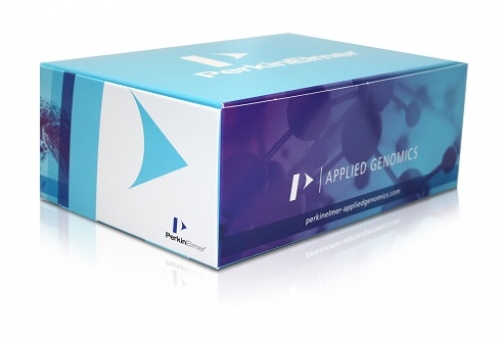
NEXTFLEX® PCR-Free DNA-Seq Kit
Eliminates amplification bias and poor sequence representation
Improves read mapping
Reduces duplicate sequences
- Product description
- Kit Contents
- Citations
Eliminate the Need for Amplification
Amplifying AT or GC rich genomic regions often leads to sequence biased nucleotide compositions and poses a serious challenge during analysis. Using specially designed master-mixed enzymes, the NEXTFLEX® PCR-Free DNA Library Prep Kit completely eliminates the need for amplification, enabling better read mapping and a reduction in duplicate sequences, leading to reduced sequence cost and bias, for more representative base identities and better de novo assembly.
In addition, the NEXTFLEX® PCR-Free DNA Sequencing Kit features patent pending Enhanced Adapter Ligation Technology, resulting in library preps with a larger number of unique sequencing reads. With these improvements to the ligation enzymatic mix, the user will now have the ability to perform ligations with longer adapters, and can expect to see better binding efficiencies. The NEXTFLEX® PCR-Free Sequencing Kit simplifies workflow by using master mixed reagents and magnetic bead based cleanup, reducing pipetting and eliminating time consuming steps in library preparation.
Exceptional Multiplexing Capabilities
Using the NEXTFLEX® PCR-Free Barcodes, the user can index 6, 12, 24, or 48 samples at once providing exceptional sequencing capacity.
The NEXTFLEX® PCR-Free DNA Sequencing Kit is designed to prepare gel-free libraries using magnetic bead based size selection from as little as 500 ng of input DNA. If you have specific insert size requirements and would like to perform agarose gel size selection, we recommend the NEXTFLEX® Agarose Gel Size Selection Kit.
Automation Solutions
The NEXTFLEX® PCR-Free DNA Sequencing Kit and NEXTFLEX® PCR-Free Modules are automated on the Tecan Freedom EVO Workstation. For more information about this customer developed automation solution read Tecan’s article, GeT with the NGS program, published in the Tecan Journal.
Features
Eliminates amplification bias and poor sequence representation
Improves read mapping
Reduces duplicate sequences
Better de novo assembly
As little as 500 ng of input DNA needed
Enhanced adapter ligation technology with NEXTFLEX® Ligation
Flexible barcode options – NEXTFLEX® PCR-Free Barcode kits contain 6 or 24 unique barcodes
Bead-based cleanup protocol
Automation-friendly workflow is compatible with liquid handlers
Barcoded adapters for multiplexing contain embedded index sequence
Kit Specs
| Cat # | Name | Quantity |
| NOVA-5142-01 | NEXTFLEX® PCR-Free DNA-Seq Kit for Illumina® Platforms | 8 RXNS |
| NOVA-5142-02 | NEXTFLEX® PCR-Free DNA-Seq Kit for Illumina® Platforms | 48 RXNS |
| NOVA-514110 | NEXTflex™ PCR-Free DNA Barcodes - 6 | 48 RXNS |
| NOVA-514111 | NEXTflex™ PCR-Free DNA Barcodes - 12 | 96 RXNS |
| NOVA-514112 | NEXTflex™ PCR-Free DNA Barcodes - 24 | 192 RXNS |
| NOVA-514113 | NEXTflex™ PCR-Free DNA Barcodes - 48 | 384 RXNS |
KIT CONTENTS
NEXTFLEX® PCR-Free End Repair Buffer Mix
NEXTFLEX® PCR-Free End Repair Enzyme Mix
NEXTFLEX® PCR-Free Adenylation Mix
NEXTFLEX® PCR-Free Ligation Mix
NEXTFLEX® PCR-Free DNA Adapter (50 µM)
Nuclease-free Water
Resuspension Buffer
REQUIRED MATERIALS NOT PROVIDED
500 ng to 3 µg of fragmented genomic DNA in up to 40 µL nuclease-free water.
NEXTFLEX® PCR-Free Barcodes – 6 / 24 (Cat # 514110, 514112)
Ethanol 80% (room temperature)
96-well PCR Plate Non-skirted (Phenix Research, Cat # MPS-499) / or / similar
96-well Library Storage and Pooling Plate (Fisher Scientific, Cat # AB-0765) / or / similar
Adhesive PCR Plate Seal (BioRad, Cat # MSB1001)
Agencourt AMPure XP 5 mL (Beckman Coulter Genomics, Cat # A63880)
Magnetic Stand -96 (Ambion, Cat # AM10027) / or / similar
Heat block
Thermocycler
2, 10, 20, 200 and 1000 µL pipettes / multichannel pipettes
Nuclease-free barrier pipette tips
Microcentrifuge
1.5 mL nuclease-free microcentrifuge tubes
Vortex
qPCR Library Quantification Kit / or / the following components:
qPCR dilution buffer: 10 mM Tris HCl pH 8.0, 0.05% Tween 20
Control Templates
qPCR Primer 1 – HPLC Purified – 5’AATGATACGGCGACCACCGA -3’
qPCR Primer 2 – HPLC Purified – 5’CAAGCAGAAGACGGCATACGA -3’
Selected Publications that Reference Using the NEXTFLEX PCR-Free DNA-Seq Kit:
Bartoli, C., Carrere, S., Lamichhane, J. R., Varvaro, L. and Cindy E. Morris, C. E. (2015) Genome Sequencing of 10 Pseudomonas syringae Strains Representing Different Host Range Spectra. Genome Announc. 3: e00379-15.
Chusova, O, et al. (2014) Effect of pine bark on the biotransformation of trinitrotoluene and on the bacterial community structure in a batch experiment. Ecological Technology. Vol. 35, Issue 19.
Chusova, O. et al. (2015) Biotransformation of pink water TNT on the surface of a low-cost adsorbent pine bar. Biodegradation. 1 – 12.
Evrony, Cai, et al. (2012) Single-Neuron Sequencing Analysis of L1 Retrotransposition and Somatic Mutation in the Human Brain. Cell. Vol. 151, Issue 3, pp. 483-496.
Hasbún, R., Iturra, C., Bravo, S., Rebolledo-Jaramillo, B. and Valledor, L. (2016) Differential Methylation of Genomic Regions Associated with Heteroblasty Detected by M&M Algorithm in the Nonmodel Species Eucalyptus globulus Labill. International Journal of Genomics. 4395153. doi: 10.1155/2016/4395153.
Hendriksen, R. S., et al. (2019) Global monitoring of antimicrobial resistance based on metagenomics analyses of urban sewage. Nature Communications. 10: 1124. doi.org/10.1038/s41467-019-08853-3.
Kawahara-Miki R., Sano S., Nunome M. et al. (2013) Next-generation sequencing reveals genomic features in the Japanese quail. Genomics. DOI: 10.1016/j.ygeno.2013.03.006.
Kocher, A., et al. (2016) Vector soup: high-throughput identification of neotropical phlebotomine sand flies using metabarcoding. Molecular Ecology Resources. doi:10.1111/1755-0998.12556.
Kofler, R., Nolte, V. and Schlötterer, C. (2015) Tempo and Mode of Transposable Element Activity in Drosophila. PLOS Genetics. doi: 10.1371/journal.pgen.1005406.
Kofler, R., Nolte, V. and Schlötterer, C. (2015) The impact of library preparation protocols on the consistency of allele frequency estimates in Pool-Seq data. Molecular Ecology Resources. doi: 10.1111/1755-0998.12432.
Ligi T, et al. (2013) Characterization of bacterial communities in soil and sediment of a created riverine wetland complex using high-throughput 16S rRNA amplicon sequencing. Ecological Engineering. DOI: 10.1016/j.ecoleng.2013.09.007.
Mändar, R. et al. (2015) Complementary seminovaginal microbiome in couples. Research in Microbiology. doi:10.1016/j.resmic.2015.03.009.
Mazueta, C., Bouchierb, C. and Popoffadoi, M. R. (2015) Draft Genome Sequence of Clostridium botulinum Strain 277-00 Type B2. Genome Announc. 3:2 e00211-15. doi: 10.1128/genomeA.00211-15.
Petersen, G., et al. (2015) Phylogeny of the Alismatales (Monocotyledons) and the relationship of Acorus (Acorales?). Cladistics. doi: 10.1111/cla.12120.
Sato S, Sesay AK, Holder AA (2013) The Unique Structure of the Apicoplast Genome of the Rodent Malaria Parasite Plasmodium chabaudi chabaudi. PLoS ONE 8(4): e61778. doi:10.1371/journal.pone.0061778.
Smidt, I., et al. (2015) Comparison of detection methods for vaginal lactobacilli. Beneficial Microbes. In press.
Suzuki, S, et al. (2014)Physiological and genomic features of highly alkaliphilic hydrogen-utilizing Betaproteobacteria from a continental serpentinizing site. Nature Communications 5, (3900).
Tiirik, K, et al., (2014) Characterization of the bacterioplankton community and its antibiotic resistance genes in the Baltic Sea. Biotechnology and Applied Biochemistry. Vol. 61, Issue 1, pp. 23–33.








